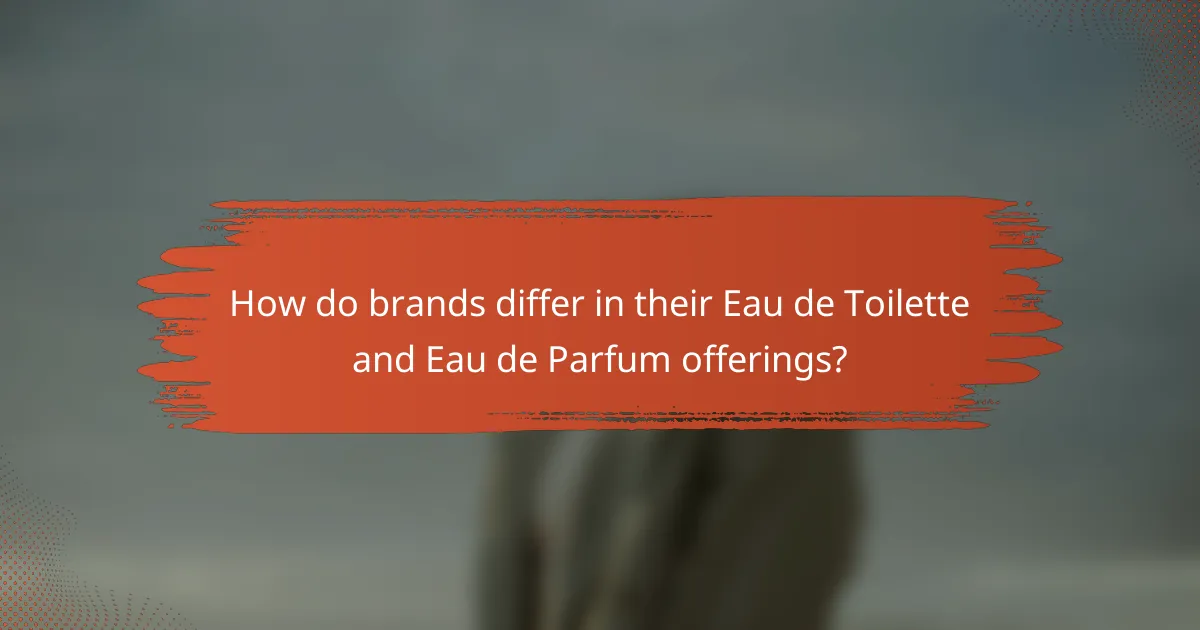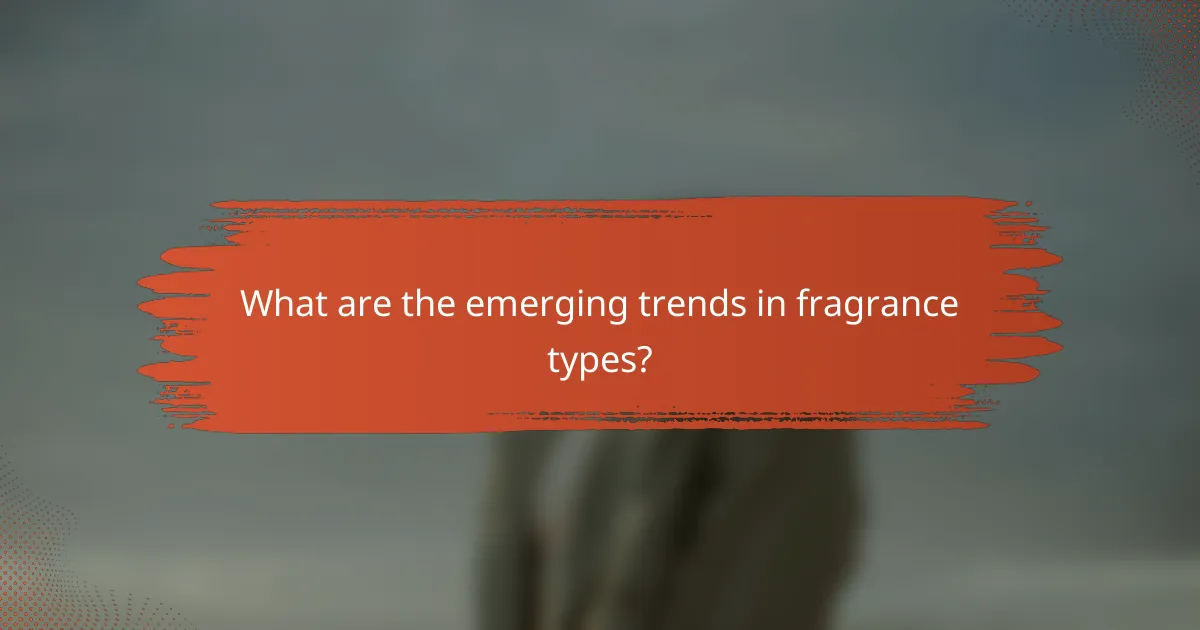When choosing between Eau de Toilette (EDT) and Eau de Parfum (EDP), understanding their differences in fragrance oil concentration is essential. EDT typically offers a lighter, more refreshing scent ideal for casual and daytime use, while EDP provides a richer, longer-lasting fragrance suitable for more formal occasions. Knowing when to use each can enhance your overall scent experience.

What is the difference between Eau de Toilette and Eau de Parfum?
Eau de Toilette (EDT) and Eau de Parfum (EDP) differ primarily in their concentration of fragrance oils. EDT typically contains around 5-15% fragrance oils, while EDP has a higher concentration of about 15-20%, resulting in a richer scent profile and longer-lasting fragrance.
Concentration of fragrance oils
The concentration of fragrance oils is the key distinguishing factor between Eau de Toilette and Eau de Parfum. EDT usually has a lighter, more refreshing scent due to its lower concentration, making it suitable for casual wear. In contrast, EDP’s higher concentration offers a more intense and complex aroma, ideal for evening or special occasions.
When choosing between the two, consider the setting and your personal preference for scent strength. If you prefer a subtle fragrance that can be reapplied throughout the day, EDT may be the better choice. For a more enduring scent that requires fewer applications, EDP is preferable.
Longevity and sillage
Longevity refers to how long a fragrance lasts on the skin, while sillage describes the scent trail left behind. Eau de Parfum generally lasts longer than Eau de Toilette, often remaining noticeable for several hours, while EDT may last around 3-5 hours before fading.
In terms of sillage, EDP tends to have a stronger presence, making it more suitable for occasions where you want to make an impression. EDT, with its lighter scent, is better for environments where a subtle fragrance is preferred.
Typical usage occasions
Eau de Toilette is often favored for daytime use, casual outings, or warm weather due to its refreshing nature. It can be reapplied as needed without overwhelming the senses. On the other hand, Eau de Parfum is ideal for evening events, formal gatherings, or colder months when a more robust scent is desired.
Ultimately, the choice between EDT and EDP should align with the occasion and your personal style. Consider having both types in your fragrance collection to suit different moods and settings effectively.

When should I use Eau de Toilette?
Eau de Toilette is best used in situations where a lighter, more refreshing fragrance is desired. It typically has a lower concentration of fragrance oils compared to Eau de Parfum, making it suitable for various casual and daytime occasions.
Daytime wear
Eau de Toilette is ideal for daytime wear due to its subtle scent profile. It provides a refreshing burst of fragrance without being overpowering, making it perfect for work or social gatherings during the day. Consider applying it in the morning for a light, invigorating start to your day.
Casual settings
This fragrance type shines in casual settings, such as brunches, picnics, or outings with friends. Its lighter scent allows for easy layering and can complement a relaxed atmosphere. Opt for Eau de Toilette when you want to smell good without overwhelming those around you.
Warmer weather
Eau de Toilette is particularly suited for warmer weather, as its lighter composition tends to be more refreshing in heat. During summer months or in tropical climates, this fragrance can provide a cooling effect. Choose it for outdoor events or beach days to keep your scent light and breezy.

When should I use Eau de Parfum?
Eau de Parfum (EDP) is best used in situations where you want a longer-lasting fragrance with a richer scent profile. Its higher concentration of fragrance oils makes it suitable for occasions that require a more pronounced aroma.
Evening events
Eau de Parfum is ideal for evening events, such as dinners or parties, where you want to leave a lasting impression. The intensity of EDP can enhance your presence in dimly lit settings, making it a popular choice for night outings.
Consider applying EDP to pulse points like the wrists and neck to maximize its impact. A few sprays can create a captivating aura without overwhelming those around you.
Formal occasions
For formal occasions, such as weddings or business meetings, Eau de Parfum offers a sophisticated scent that complements elegant attire. Its depth can convey confidence and professionalism, making it a fitting choice for these settings.
Choose a fragrance that aligns with the event’s tone; floral or woody notes often work well for formal gatherings. Apply sparingly to maintain a refined presence.
Colder weather
Eau de Parfum is particularly effective in colder weather, as the scent can project better in lower temperatures. The richness of EDP helps to combat the dilution of fragrance that can occur in chilly climates.
In winter, opt for warmer, spicier notes that resonate with the season. Layering EDP with complementary body lotions can enhance longevity and create a cohesive scent experience.

What factors should I consider when choosing between them?
When choosing between Eau de Toilette (EDT) and Eau de Parfum (EDP), consider factors like scent intensity, longevity, and occasion. EDT typically has a lighter concentration of fragrance oils, making it suitable for casual wear, while EDP offers a richer scent that lasts longer, ideal for special events.
Personal preference
Your personal preference plays a crucial role in deciding between EDT and EDP. Some people prefer the subtlety of an EDT for everyday use, while others enjoy the depth and complexity of an EDP. Testing both types on your skin can help you determine which aligns better with your taste.
Consider how you want your fragrance to make you feel. If you enjoy a fresh, airy scent, an EDT might be more appealing. Conversely, if you prefer a bold, long-lasting fragrance, an EDP could be the better choice.
Skin type and chemistry
Your skin type and chemistry can significantly affect how a fragrance smells and lasts. Oily skin tends to hold scents longer, making EDP a good option, while dry skin may require more frequent reapplication of EDT. Understanding your skin’s behavior with fragrances can guide your choice.
Additionally, the way a fragrance interacts with your skin can vary. If you find that certain scents fade quickly on you, an EDP might provide the lasting power you need. Testing fragrances on your skin before purchasing is advisable to see how they develop over time.
Budget considerations
Budget is an important factor when choosing between EDT and EDP. Generally, EDPs are more expensive due to their higher concentration of fragrance oils, which can lead to longer-lasting scents. EDTs, being lighter, are often more affordable and can be a great option for those looking to save.
Consider how often you plan to wear the fragrance. If you intend to use it daily, an EDT may be a cost-effective choice. However, for special occasions, investing in a high-quality EDP could be worthwhile for its longevity and richness.

How do brands differ in their Eau de Toilette and Eau de Parfum offerings?
Brands often differentiate their Eau de Toilette (EDT) and Eau de Parfum (EDP) offerings primarily through concentration levels and scent longevity. Typically, EDPs contain a higher concentration of fragrance oils, leading to a richer scent that lasts longer compared to EDTs, which are lighter and more suitable for casual wear.
Chanel fragrance comparisons
Chanel offers a range of fragrances in both EDT and EDP formats, with iconic scents like Chanel No. 5 available in both concentrations. The EDT version tends to be fresher and more suitable for daytime use, while the EDP provides a deeper, more intense experience ideal for evening wear.
For example, Chanel No. 5 Eau de Parfum has a higher oil concentration, resulting in a longer-lasting scent that can endure for several hours. In contrast, the Eau de Toilette version may require reapplication throughout the day.
Dior fragrance comparisons
Dior’s fragrance line includes popular options like Sauvage, available in both EDT and EDP. The Eau de Toilette version is often perceived as more vibrant and crisp, making it a great choice for warm weather or casual outings.
The Eau de Parfum variant, however, offers a richer and more complex scent profile, making it suitable for formal occasions or evening events. Users often find that the EDP lasts significantly longer, sometimes up to eight hours or more.
Jo Malone fragrance comparisons
Jo Malone specializes in layering fragrances, and their offerings include both EDT and EDP options. The brand’s EDTs, such as Lime Basil & Mandarin, are light and refreshing, perfect for everyday wear or layering with other scents.
In contrast, Jo Malone’s EDPs, like Peony & Blush Suede, provide a more concentrated and luxurious scent experience. These are often chosen for special occasions due to their lasting power and depth, typically lasting around six to eight hours on the skin.

What are the emerging trends in fragrance types?
Emerging trends in fragrance types indicate a growing preference for personalized and sustainable scents. Consumers are increasingly seeking unisex options and natural ingredients, reflecting a shift towards inclusivity and environmental consciousness.
Unisex fragrances
Unisex fragrances are designed to be worn by anyone, regardless of gender, and are gaining popularity due to their versatility. These scents often blend traditionally masculine and feminine notes, creating a balanced aroma that appeals to a broader audience.
When choosing a unisex fragrance, consider the scent profile that resonates with you. Popular notes in unisex options include citrus, woody, and herbal elements, which can provide a fresh and inviting experience. Brands like Jo Malone and Tom Ford offer a range of unisex fragrances that cater to diverse preferences.
To effectively wear unisex fragrances, apply them lightly to pulse points such as wrists and neck. This allows the scent to develop naturally throughout the day. Avoid overpowering applications, as subtlety is key in showcasing the fragrance’s complexity.
